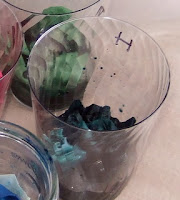Reds are strong; yellows are weak; and it takes a lot of black to make black. I use less dye for the reds and more for the yellows & blacks. The blues are my standard. I add 1 teaspoon red or 2 teaspoons blue or 3 teaspoons yellow (or black) powdered dye to 320 ml (about a cup and a half) of urea water (1 cup urea to 1 quart of water). I might make the concentration stronger on certain occasions.
TO TRANSLATE these weighted proportions to actual proportions of powdered dye...
Leave the red amounts alone.
Multiply each blue amount by 2
Multiply each yellow and black amount by 3.
(You may be able to simplify at this point, for instance 3:6:9 is the same as 1:2:3.)
I use the U.S. system for dry measures and large amounts of liquid, and metric for small amounts of liquid. (Mixed up, I know, but it works for me.) I always mix my liquid dyes to a standard concentration (below), then measure out the liquid according to the proportions in the recipe.
|
| | | YELLOWS |
| 1/32 teaspoon | 10 ml | 5 ml | ~ 3 ml |
| 1/16 teaspoon | 20 ml | 10 ml | ~ 7 ml |
| 1/8 teaspoon | 40 ml | 20 ml | 13 ml |
| 1/4 teaspoon | 80 ml | 40 ml | 27 ml |
| 1/2 teaspoon | 160 ml | 80 ml | 53 ml |
| 1 teaspoon | 320 ml | 160 ml | 107 ml |
| 2 teaspoon | 640 ml | 320 ml | 213 ml |
| 1 Tablespoon | 960 ml | 480 ml | 320 ml |
| 4 teaspoons | 1280 ml | 640 ml | 426 ml |
| 5 teaspoons | 1600 ml | 800 ml | 535 ml |
| 2 Tablespoons | 1920 ml | 960 ml | 642 ml |
For the tiny amounts I use measuring spoons from a gourmet shop labeled pinch, dash, and smidge, which are 1/8, 1/16, and 1/32 teaspoons. Even so, things aren't very accurate in these amounts, which is usually OK for me. If accuracy matters, I paste up more than I need, and measure the liquid accurately.
Before getting started, I work out how much total dye I need for the amount of fabric and depth of shade I'm going for. Let's say I'm dyeing a quarter yard a dark and even purple, requiring 500 ml of liquid dye. For a color recipe of 3 parts Fuchsia to 7 parts Turquoise, that works out to 150 ml of Fuchsia and 350 ml Turquoise. I look on the chart to find the next larger amount of each color. For Fuchsia I'll mix 1/2 teaspoon powder into 160 ml of urea water. For Turquoise, I would mix up 1 and 1/4 teaspoon powder into 360 ml of urea water. I'll measure out the exact amounts and dye my fabric in it.









































